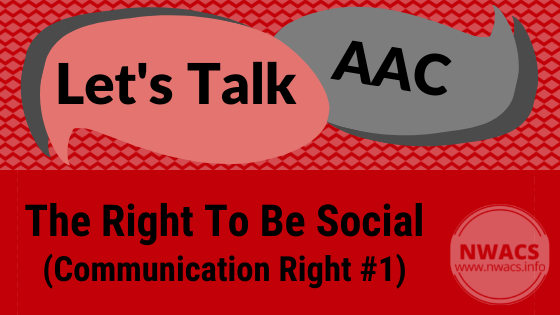Welcome back to Let's Talk AAC - a series of questions and topics for discussion. NWACS will occasionally post a question or topic along with some related information. We hope that you will join in the conversation by adding your experiences, resources, related research, etc. in comments so that we can all learn and benefit from each other's knowledge and experience.
reading time: 2 minutes
Right #1 of the Communication Bill of Rights reads: the rights to interact socially, maintain social closeness, and build relationships.
Social closeness, engagement, and participation are important to our well-being and overall quality of life. In fact, feeling socially connected to others is so essential that it is considered a basic human need.
social closeness - our perception about how embedded in social networks we are
social connection - feeling close and connected to others
Being social is a basic human right. It is a basic human need. And it is also an area of communicative competence.
To develop relationships, we need:
opportunities to interact socially with a broad range of people
the desire to interact and the communicative means to do so
if early attempts to be accepted or to communicate are not successful, a person may not be motivated to interact socially
if the vocabulary needed for social exchanges is not accessible, or the person has not been taught to use the relevant vocabulary for various social communication needs, a person may not be able to successfully initiate and/or maintain social interactions
effective communication partners
supports to develop and maintain relationships, including:
providing information and training to communication partners
supporting a mix of communication methods for reciprocal, social interactions
e.g., nonverbal communication, light-tech communication tools, high-tech communication tools, interactive activities
using strategies to facilitate and promote social interactions
How do we promote this right for our AAC users?
Here are a few ideas:
Help people with disabilities understand and advocate for their communication rights.
Make sure that everyone is aware of the Communication Bill of Rights.
Provide opportunities for AAC users to interact with a wide range of people.
Inform and train communication partners on how they can best communicate and interact with AAC users.
Provide culturally and linguistically responsive supports for AAC users to develop this skill area.
Make sure AAC users have access to a variety of ways to interact and build/maintain relationships.
Provide AAC users with relevant vocabulary (e.g., greetings, social comments, common “quick fire” utterances, question words, etc.).
Model using their AAC system to interact socially, build relationships, and maintain closeness.
What would you add? Join the conversation by commenting below! Share your thoughts, ideas, strategies, resources, and/or tips for supporting AAC users' ability to interact socially, maintain social closeness, and build relationships.
References and related resources:
Alant, E. (2017). Augmentative and Alternative Communication: Engagement and Participation. Plural Publishing.
Blackstone, S. W., & Hunt-Berg, M. (2012). Social Networks: A Communication Inventory for Individuals with Complex Communication Needs and their Communication Partners; Verona, Wisconsin: Attainment Company, Inc.
Brady, N. C., Bruce, S., Goldman, A., Erickson, K., Mineo, B., Ogletree, B. T., Paul, D., Romski, M., Sevcik, R., Siegel, E., Schoonover, J., Snell, M., Sylvester, L., & Wilkinson, K. (2016). Communication services and supports for individuals with severe disabilities: Guidance for assessment and intervention. American Journal on Intellectual and Developmental Disabilities, 121(2), 121–138.
Hunt, P., Doering, K., Maier, J., and Mintz, E. (2009). Strategies to Support the Development of Positive Social Relationships and Friendships for Students Who Use AAC. In G. Soto & C. Zangari (Eds) Practically Speaking: Language, Literacy, & Academic Development for Students with AAC Needs. Paul H. Brookes Publishing Co.
Mayne, L.E., & Rogers, S.M. (2020). Augmentative and Assistive Communication with Children: A Protocol and Intervention Plan to Support Children with Complex Communication Profiles (1st ed.). Routledge. https://doi.org/10.4324/9780429317774
Silverman, Ari B., "Well-being, meaningful activity, and social closeness for persons with disabilities: Findings from the American Time Use Survey (ATUS)" (2018). Graduate Student Theses, Dissertations, & Professional Papers. 11279. https://scholarworks.umt.edu/etd/11279
Related posts:




